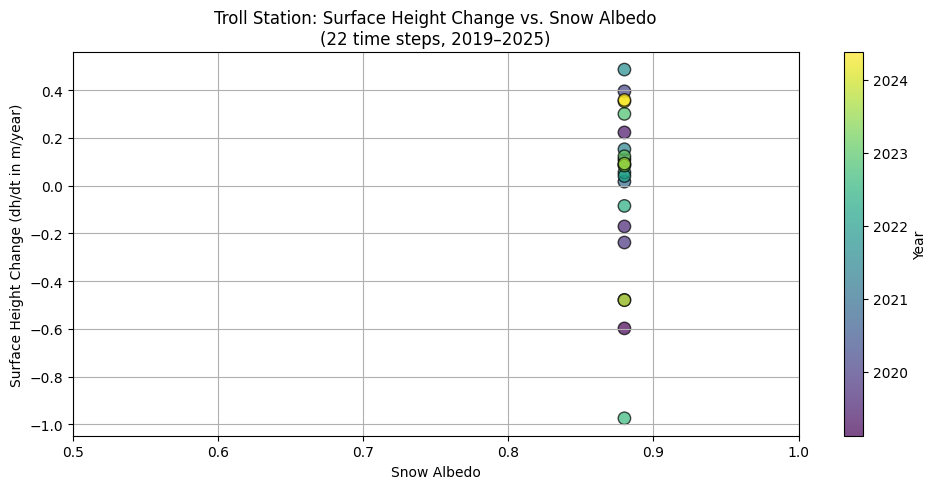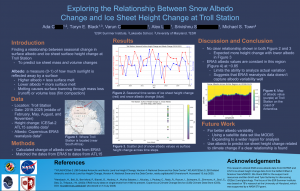On a warm July day in Seattle, I wasn’t thinking about the heat outside. Instead, my mind was on the sunlight reflected thousands of miles away off the surface of Antarctica. I was investigating a deceptively simple question: how do seasonal changes in albedo affect surface height changes in ice sheets near Troll Station?
My curiosity was rooted mostly in biology when I arrived at ESR’s Summer Institute. During the first few days here, I learned about ice sheets, glaciers, and the processes that shaped them. But one detail in particular caught my attention. I was reading about biological processes and I found that microorganisms like algae can grow on ice and snow, darkening the surface and lowering its reflectivity, or albedo. That change in color can lead to more surface melt, and ultimately, to changes in the elevation of the ice sheet. As fascinating as the biology is, it turned out to be too specific for this project. So I broadened the question to just albedo. Could I find any general relationship between albedo and ice sheet height change? If such a link exists, it could help predict future melting patterns and ice sheet height change using observable surface properties like albedo.
To explore my research question, I focused on Troll Station, a Norwegian research base in East Antarctica. I took surface height change measurements from NASA’s ICESat-2 satellite (ATL15 product), which uses laser pulses to measure ice elevation. For snow albedo, I used Copernicus ERA5, a global reanalysis dataset that combines observational data with weather prediction models. Using Python and tools like xarray, matplotlib, and pandas, I created time series graphs to visualize changes in both variables. I also generated a scatter plot and map plot to check the snow albedo value.

As seen with the scatter plot above, the ERA5 albedo data in this region proved to be relatively constant with values around 0.88. This value is likely too high. In reality, snow albedo typically averages closer to 0.83, reflecting a mix of fresh, clean snow and older or melting snow. Albedo also tends to drop in the near-infrared range, where ice absorbs more light. The lack of variation in the data made it difficult to find any relationship with surface height change. This may be due to ERA5’s modeling approach, since it probably smoothed out any fine-scale changes.
Although this meant the original research question didn’t yield a strong result, it did raise valuable next steps. We could use satellite-based albedo data from MODIS, a satellite instrument that regularly captures detailed images of Earth’s surface in visible and near-infrared light, providing more accurate measurements of snow and ice. Expanding the study area to include other parts of Antarctica or Greenland, where there’s more accurate albedo data, could also provide more meaningful results. If a relationship between albedo and height change is found, further analysis would be needed to rule out other contributing factors, such as glacier dynamics, and to ensure the pattern isn’t just a coincidence.
Despite the challenges, this project helped me better understand the limitations of climate models, the importance of choosing the right dataset, and how surface processes like albedo can connect to larger-scale ice sheet dynamics. It also reminded me that in climate science, not every result is conclusive. However, even small steps can contribute to a clearer picture of our changing planet.
Find out more about my work by viewing my poster:
Exploring the Relationship Between Snow Albedo Change and Ice Sheet Height Change at Troll Station

